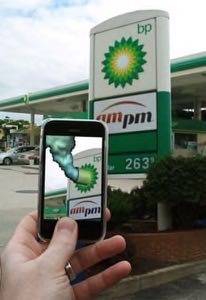The use of logos or insignias to symbolize a product, service or company is one of the oldest ways for a brand to stand out from competitors and similar products. These days, laws protect the misuse or copying of trademarked brand logos, but as technology evolves and companies find new ways to market their brands, these laws must adapt to cover new possibilities for infringement.

Augmented reality is a popular technology for new media advertising, allowing images, logos and markers to become triggers for 3D experiences on computers and mobile devices. It also could create 21st century legal dilemmas. Who has the right to create AR experiences from trademarked brand logos? Is the age of “augmented reality trademark infringement” rapidly approaching?
Consider a new application being developed in reaction to the oil spill in the Gulf of Mexico. The iPhone app – which is still in development – is called “the leak in your hometown,” and will let users augment any existing real-world British Petroleum (BP) logo with a virtually rendered oil pipe that is gushing with oil. The app developers, Mark Skwarek and Joseph Hocking, in their own words describe the app as “turning [BP’s] own logo against them.”

“This repurposing of corporate icons will offer future artists and activists a powerful means of expression which will be easily accessible to the masses and at the same time will be safe and nondestructive,” they say.
Nondestructive in what sense? Yes, virtually spilling oil is safe for the planet, but the use of BP’s own logo is destructive to their brand and the company has the right to protect it. It is true that BP’s brand has already been irrevocably damaged due to the spill, and it is also true that augmented reality is a niche technology not likely to be a strong vehicle for further brand damage (yet), but BP still has the right to control how its logo is used.
Would BP actually benefit from defending their trademark in this way? Erik J. Heels, a trademark lawyer with the Clock Tower Law Group in Maynard, Massachusetts, says BP would be better off simply letting it go.
“The analysis falls in two categories,” Heels told ReadWriteWeb. “First, what does the law allow a rights holder to do? And second, what is the smart thing to do from a business and public relations perspective? Even if BP wanted to take action against them, I don’t think they would win the battle of public opinion, it could backfire on them.”
Trademark law, Heels says, was created to protect similar products and services from being confused with one another, and it is unlikely a person using this app would be unsure of whether it was or wasn’t officially endorsed by BP. Free speech, parody and commentary are other areas of law that overlap with this issue, which makes any action from BP even more unlikely.
If any entity is going to challenge the existence of the application, it is likely to be Apple, which has had no problem keeping any app they deemed questionable from passing inspection. It is unlikely that this application will get by Apple in its current state, but an updated version using a different logo most certainly would. In the future, however, if augmented reality takes off and is part of our everyday lives, an application like this could attract more legal attention from a popular brand.
Should brands have the same protections over the use of their logos in augmented reality (or specifically as the marker to launch an AR experience) as they do in actual reality? Who has the right to use trademarks as AR triggers? These are questions brands will be faced with as AR continues to expand its presence in digital marketing.
In an interview with UgoTrade author Tish Shute, AR developer Anselm Hook discussed what he calls the “imageDNS” – a name space for images – which could potentially be used to solve some of these issues.
“When an image becomes a kind of hyperlink – there’s really a question of what it will resolve to,” said Hook. “Will your heads up display of McDonalds show tasty treats at low prices or will it show alternative nearby places where you can get a local, organic, healthy meal quickly?”
Trademark laws and image disputes aside, the potential for augmented “ad busting” and virtual activism is promising on the augmented reality platform, and more mobile apps will certainly surface in this space. I can even see an app in the future that will let activists spill virtual blood on fur coats, so developers, please get to work on “Fur is MurdAR.”










